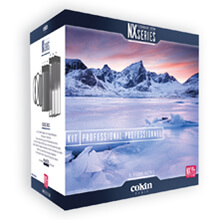
Why Use Filters in a Digital Age?
By David Southard | Wildlife Photographer, Wild Arena
I am often asked about the use of filters, especially when photographing landscapes. Continued advancement in computer-based editing of digital images has caused many people to question if filters still have a place in modern image capture, leading to comments like “surely you can just do all those things in processing?” Let’s quickly look at why filters still have a place in modern photography.
There is no doubt that modern editing software and the resolution of the digital files gives us a huge range of post processing options. We can relatively easily adjust exposure, colour balance, detail and sharpness in our images, BUT there will always be limits to what is possible. Let us ponder some scenarios.
Does the picture file contain all the information?
This is our first key thought; we can only alter or manipulate elements of the image (in software) if the data is there in the first place. Imagine a classic landscape image where we have an interesting scene with dark shadow areas, topped by a very bright sky with important cloud detail. This range in the relative brightness of the elements (dynamic range), provides a challenge for the camera. It cannot record both dark/shadow details at the same time as bright/highlight information. In short, it has a finite dynamic range. This forces us to decide which parts of the picture we want to prioritise - do we want the darker elements looking right with over exposed highlights, or do we want the highlights looking correct with shadow areas looking too dark? One option of course, is to tackle this by using a multiple image, or HDR (high dynamic range) technique, where we use software to merge, blend or combine images with different exposures into one.
If we don’t want to do this, we will need to do something to balance out the brighter sky with the darker landscapes. The solution? A graduated neutral density filter. Graduated ND filters have a clear base combined with a darker top, that graduates or transitions smoothly in the centre. If we place the darker half at the top of our scene, covering our sky, it reduces the brightness of this part of the picture to match it with the landscape below, enabling us to capture detail in both parts, without software, in a single image. So, Graduated ND filters enable us to do something physically that even clever software will struggle with.

Can I create shutter speed effects in software?
We can create different effects in our images by shooting at different shutter speeds. For example, photographing moving water at very slow speeds creates a blurry effect which can look quite ethereal and relaxing. Now this may also be possible to re-create in software, but it is arguably easier to create the effect as you capture the initial image. The problem here is, are we able to adjust our settings to reduce the shutter speed low enough to capture the effect, if the daytime lighting conditions are too bright?
Enter our second useful optical device, the neutral density filter! Much like the graduated neutral density filter, ‘NDs’ reduce the amount of light entering the camera, but across the entire image. NDs are normally measured in stops. A stop is a halving or a doubling of the amount of light, so a ND filter rated at ‘1-stop’ will halve the quantity of light, reducing it by 50%. A ‘3-stop’ ND, will halve, halve and halve again, reducing the amount of light by 87.5%. These steps really open up our options for using much slower shutter speeds, even in daylight conditions. Some ND filters are available that reduce the light by up to 15 stops, enabling very slow speeds, even in the middle of the day.
Swipe left and right for before and after shots
The same waterfall scene photographed with and without filters.
Can I remove reflections in certain areas of a scene?
Reflections on water or even leaves on trees, can negatively affect how a picture looks. Again, some of these effects can be reduced in post-production, but we have a third lens filter that can make a big difference when the picture is captured.
The polariser filter (these days usually referred to as circular polarisers), enables us to control how reflections appear on our subjects. The filter can be rotated in its mount and, as we do so, the reflective areas in the scene change. This means we can reduce a reflection on water, bringing out the details and colour of the water, or improve the intensity of the colour in tree foliage.
Polarising filters also have the added characteristics of increasing the intensity of blues in the sky, reducing haze in distant landscapes and reducing the amount of light entering the camera by usually around 2 stops (much like the ND filters).

Do I have full control of colour tone?
Broadly speaking it is pretty easy to adjust the colour tone of images in post processing. This would normally be achieved by adjusting the colour temperature between warmer (yellow/orange) tones, or cooler (blue) tones in the picture. However much like the point I make earlier in this article, it can be useful to have broadly the right colour data in our images BEFORE processing, by using colour correction filters as we capture the pictures. By fitting filters with a warmer or cooler tone we can alter the basic colour data in our images, which may then give us significantly better options in colour adjustment when we take the pictures into processing.
Of course, there are many different filters that can create many more effects than these four examples, but the main take away should be that certain effects are hard (if not impossible) to replicate in your software. Beyond such technical reasons, there is something else that drives people to feel passionately about using filters.
Influencing images at the time of capture
There is a view that the creative process of photography centres around the initial image capture, and any equipment or techniques that expand our options when we are behind the camera, will broaden the whole creative experience. Filters fall very much within this idea, literally enabling us to conceive, record and instantly review, creative thoughts as we have had.
Summary
When all is said and done, photography is made up of options and choices, and whilst some people love their filters, it may not be the right accessory for everyone. Hopefully, in this short article, I have explained why filters are still capable of enhancing our images and can work alongside any post-production software we might already be using. Why not think about using filters for the next visual story you want to tell?

For more information please contact our Sales Desk:
+44 (0)1457 851000 | sales@holdan.co.uk.
27 Nov 2025
PTZOptics: Versatile, Professional PTZ Solutions for Every Production Environment
19 Nov 2025
Expanding Possibilities: Introducing Sonnet Technologies’ High-Performance Solutions for Apple and Professional Workflows
14 Nov 2025
Take Command of Your Creativity: Meet the Elgato Stream Deck Family
26 Sep 2025
Lumens VC-TR60A PTZ Camera Earns Microsoft Teams Certification
-Nuances-Extreme-Reverse-Gnd8.jpg)
-Nuances-Extreme-ND1024.jpg)





